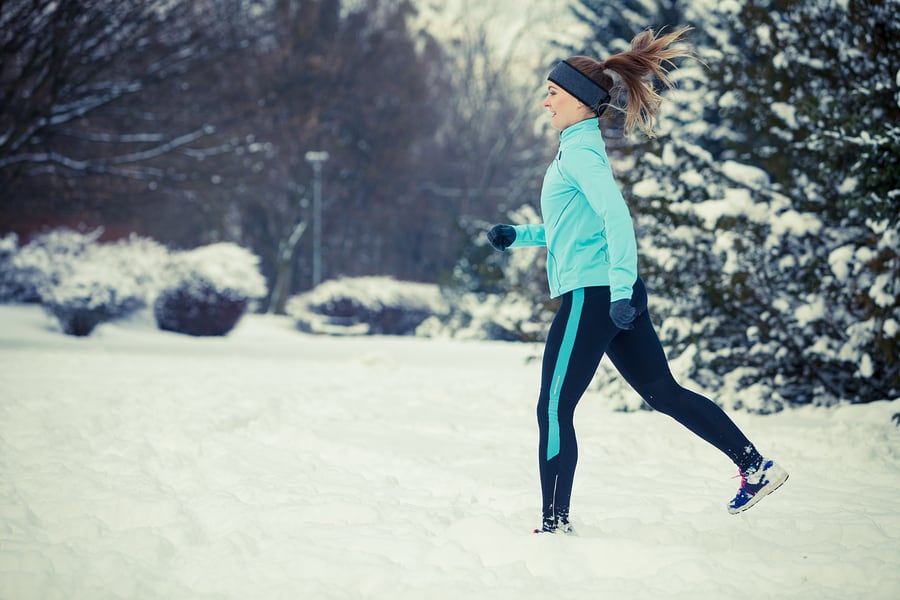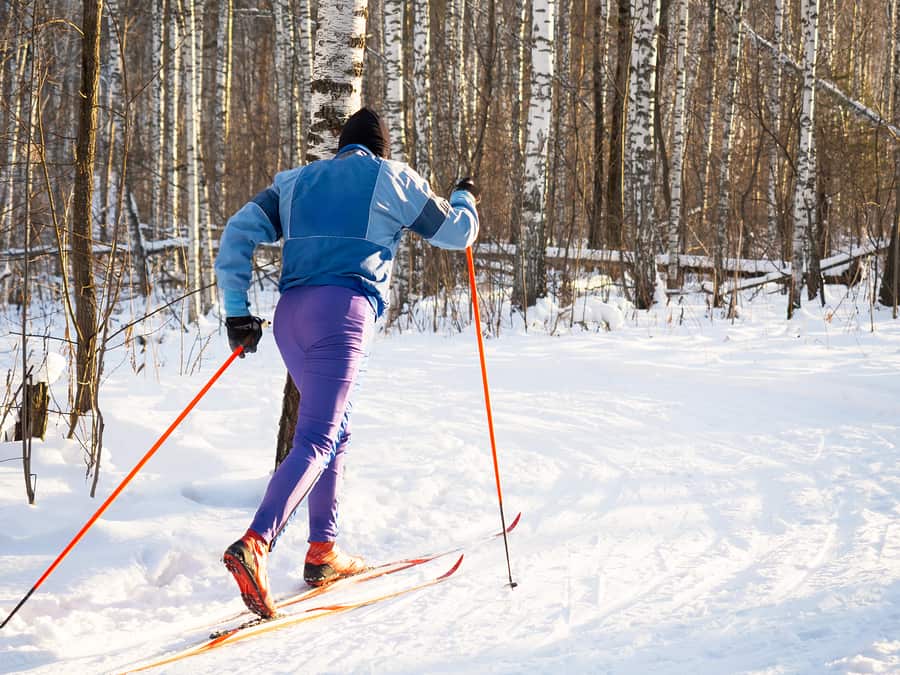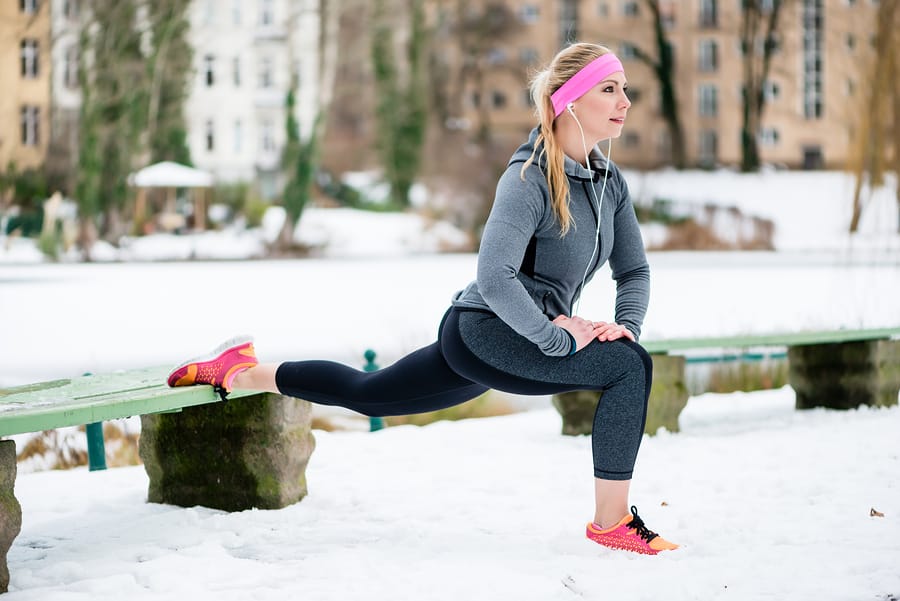Progress with physical fitness often feels like it takes forever. Meanwhile, it seems things go downhill at supersonic speed if you lag behind. You likely have dozens of very legitimate excuses to skimp or pause your exercise from time to time. Some, such as an injury, are unavoidable, but one factor that you don’t have to let influence your workout is winter weather.
In this article, we’re going to talk about how you can keep your fitness up – even in the coldest weather.

Why You Should Winterize Your Workout
You winterize your home, wardrobe, vehicle, and other essential components so they’ll continue to function through the snow, ice, and frigid temperatures of colder seasons. Your workout routine deserves the same winterization so it will continue to serve you and your long-term health goals throughout the entire year.
Exercise has quite a few essential benefits, including:
- Mood stability
- Lower risk of /effect of disease
- Healthy body weight
- Immune system function
- Sleep quality
- Physical strength and agility
- Stamina
Yet, there’s a huge ‘but’ to the benefits here. They’re contingent on regularly getting enough exercise. As Harvard Health Publishing points out, the minimum threshold for exercise to be most beneficial is that you’re burning 700- 1,000 calories per week through physical activity. The translation is that you can’t hibernate from exercise if you want the health rewards.

Winter Exercise Is Particularly Important
Summer exercise often has some very tangible goals, such as fitting into a swimsuit. Winters are often spent indoors and without a lot of fanfare, making fitness/body goals more obscure. Yet, this is actually the time your body and mind may be in most need of its benefits.
Staying inside limits sunlight exposure, especially in areas where the sunlight is frequently obscured by winter weather. You get vitamin D from sunlight, which is essential to bone, mental, joint, and immune health.
Winter exercise offers a natural source of warmth to heat up your core body temperature. You’ll likely see savings in an array of areas, including your electric bill and waistline.
Exercising during the winter months helps keep your immune system strong during a very vulnerable time. What better time to have a tip-top immune system than cold and flu season?
Have you heard the term “winter blues?” Winter exercise also helps raise endorphin levels to naturally battle seasonal affective disorder, which can cause depression and anxiety.
You can burn off winter comfort foods and added calories from being more confined and engaging in holiday splurge eating.
Tips To Winterize Your Exercise Routine
Now that you know why you shouldn’t skimp or pause your exercise during the winter, let’s take a look at how you can get around common problems that plague winter exercising:
1. Stay Motivated
Winter clothing offers warmth, but it’s loose comfort and bulk can hide the effects of not exercising. Wear fitted clothing under your heavy layers so that you’ll remember the importance of your exercise routine and be attuned to any weight changes.
2. Adjust Your Timing
Depending on where you live, it may be warmest in the mornings when the sun first breaks. Morning is also the time when you’re most motivated and energized to exercise. The shorter days of winter may mean that it’s dark outside before and after you get off work; if so, ask yourself if you could use part of your lunch break to fit in exercise.
3. Switch Up How You Exercise
Everyone has a preferred exercise method, but winter asks you to be adaptable. Avid outdoor exercises can give inside venues a whirl. Think indoor pool facilities for swimmers, treadmills for runners, yoga studios, and spin classes for bikers. Try free spaces like malls and dance halls if cost is an issue. On the other hand, you can embrace winter by using common winter activities like sledding, snowboarding, ice skating, or skiing as a form of outdoor winter exercise.

4. Partner Up
Research shows that you’re more likely to exercise consistently, regularly, and harder if you have a partner. Having a friend can also make you more comfortable trying new ways to exercise, and it makes exercise feel like a social need as much so as a physical need. According to {2} AARP, your partner’s good fitness habits can even rub off on you. So, pick wisely.
5. Make Each Move Count
When the weather is really harsh, you may need to stop and remember that exercise doesn’t revolve around labels and dedicated spaces. Almost all of your choices can be turned into exercise. Instead of taking motorized transportation, try walking and using the stairs. Even shoveling snow counts as exercise. Keeping an activity journal can really help show you how active choices within your daily living schedule add up.
Precautions For Winter Workouts
You know that summer heat has potential risks, such as dehydration and heat stroke, for exercisers. Exercising in winter temperatures also has risks and precautions, including:
- Dress to stay dry as much as warm. Water is a heat conductor, meaning your body loses heat when it sweats or is dampened by snow or sleet. This leaves you more likely to cut your workout short or even develop hypothermia. Cotton acts like a sponge for moisture. So, go with synthetic fibers that wick water away.
- Layer your active wear with a synthetic closest to your skin, an insulated middle layer for warmth, and a protective outer layer against wet/windy conditions.
- Wear bright and reflective colors that contrast with the environment for outdoor workouts. Motorists in poor weather conditions have limited visibility and stopping power.
- Cold conditions cause the body to hoard blood at your core to protect vital organs, meaning your extremities and head are most prone to frostbite. Wear accessories to protect your face, hands, and feet, and don’t forget to choose synthetic fibers over cotton. Warm up indoors with 10 minutes of aerobic exercise to get your blood circulating. Do the same for your post-workout cool down.
- Athletic shoes are designed to let heat escape.They’re also rarely waterproof. Try a shoe cover that slips over your athletic shoes to insulate and waterproof them for outdoor winter exercise.
- Cold air is drying. Apply moisturizer frequently, hydrate adequately. and use Vaseline to block wind-bite.
- Don’t forget to factor windchill into the risk for hypothermia and frostbite. According to the Mayo Clinic, frostbite can occur to exposed skin within just 30 minutes or less when wind chill levels fall to minus 18 F.

Winter Workout Tips – In Summary
In closing, the importance and benefits of year-round exercise is obvious. If you winterize your exercise routine and take the appropriate precautions, then you can ensure your fitness goals and gains never lapse because of the environment.
Want more? Check out our Cold Weather Training Tips.
References
1. https://www.health.harvard.edu/healthbeat/the-secret-to-better-health-exercise
3. https://www.mayoclinic.org/healthy-lifestyle/fitness/in-depth/fitness/art-20045626

Tim is the founder of FitAtMidlife.com – an avid gym rat for 30+ years, he’s a reviewer of many, many shoes – and founder of the Speed Bag Gathering – the world’s only gathering of speed bag punching enthusiasts. See more gym reviews at Tim’s YouTube channel.


